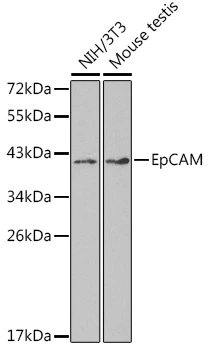![IHC-P analysis of human breast carcinoma tissue using GTX28667 EpCAM antibody [VU-1D9]. IHC-P analysis of human breast carcinoma tissue using GTX28667 EpCAM antibody [VU-1D9].](https://www.genetex.com/upload/website/prouct_img/normal/GTX28667/GTX28667_1328_IHC-P_w_23060722_693.webp)
IHC-P analysis of human breast carcinoma tissue using GTX28667 EpCAM antibody [VU-1D9].
EpCAM antibody [VU-1D9]
GTX28667
ApplicationsFlow Cytometry, ImmunoFluorescence, Western Blot, ImmunoCytoChemistry, ImmunoHistoChemistry, ImmunoHistoChemistry Paraffin
Product group Antibodies
TargetEPCAM
Overview
- SupplierGeneTex
- Product NameEpCAM antibody [VU-1D9]
- Delivery Days Customer9
- Application Supplier NoteIHC-P: 1-2 microg/ml. *Optimal dilutions/concentrations should be determined by the researcher.Not tested in other applications.
- ApplicationsFlow Cytometry, ImmunoFluorescence, Western Blot, ImmunoCytoChemistry, ImmunoHistoChemistry, ImmunoHistoChemistry Paraffin
- CertificationResearch Use Only
- ClonalityMonoclonal
- Clone IDVU-1D9
- Concentration200 ug/ml
- ConjugateUnconjugated
- Gene ID4072
- Target nameEPCAM
- Target descriptionepithelial cell adhesion molecule
- Target synonymsBer-Ep4, BerEp4, DIAR5, EGP-2, EGP314, EGP40, ESA, HNPCC8, KS1/4, KSA, LYNCH8, M4S1, MIC18, MK-1, MOC-31, TACSTD1, TROP1, epithelial cell adhesion molecule, adenocarcinoma-associated antigen, cell surface glycoprotein Trop-1, epithelial glycoprotein 314, human epithelial glycoprotein-2, major gastrointestinal tumor-associated protein GA733-2, membrane component, chromosome 4, surface marker (35kD glycoprotein), trophoblast cell surface antigen 1, tumor-associated calcium signal transducer 1
- HostMouse
- IsotypeIgG1
- Protein IDP16422
- Protein NameEpithelial cell adhesion molecule
- Scientific DescriptionThis gene encodes a carcinoma-associated antigen and is a member of a family that includes at least two type I membrane proteins. This antigen is expressed on most normal epithelial cells and gastrointestinal carcinomas and functions as a homotypic calcium-independent cell adhesion molecule. The antigen is being used as a target for immunotherapy treatment of human carcinomas. Mutations in this gene result in congenital tufting enteropathy. [provided by RefSeq, Dec 2008]
- Storage Instruction2°C to 8°C
- UNSPSC12352203
References
- Transcriptional changes in the mammary gland during lactation revealed by single cell sequencing of cells from human milk. Twigger AJ et al., 2022 Jan 28, Nat CommunRead more
- Virtual-freezing fluorescence imaging flow cytometry. Mikami H et al., 2020 Mar 6, Nat CommunRead more
- Preferential capture of EpCAM-expressing extracellular vesicles on solid surfaces coated with an aptamer-conjugated zwitterionic polymer.Read more
- Optimisation of immunofluorescence methods to determine MCT1 and MCT4 expression in circulating tumour cells. Kershaw S et al., 2015 May 10, BMC CancerRead more
- Mutational analysis of circulating tumor cells from colorectal cancer patients and correlation with primary tumor tissue. Lyberopoulou A et al., 2015, PLoS OneRead more
- Superficial scrapings from breast tumors is a source for biobanking and research purposes. Ma R et al., 2014 Jul, Lab InvestRead more
- High-purity separation of cancer cells by optically induced dielectrophoresis. Chen HH et al., 2014 Apr, J Biomed OptRead more
- Hyaluronan synthase HAS2 promotes tumor progression in bone by stimulating the interaction of breast cancer stem-like cells with macrophages and stromal cells. Okuda H et al., 2012 Jan 15, Cancer ResRead more
- Characterization of the epithelial cell adhesion molecule (EpCAM)+ cell population in hepatocellular carcinoma cell lines. Kimura O et al., 2010 Oct, Cancer SciRead more

